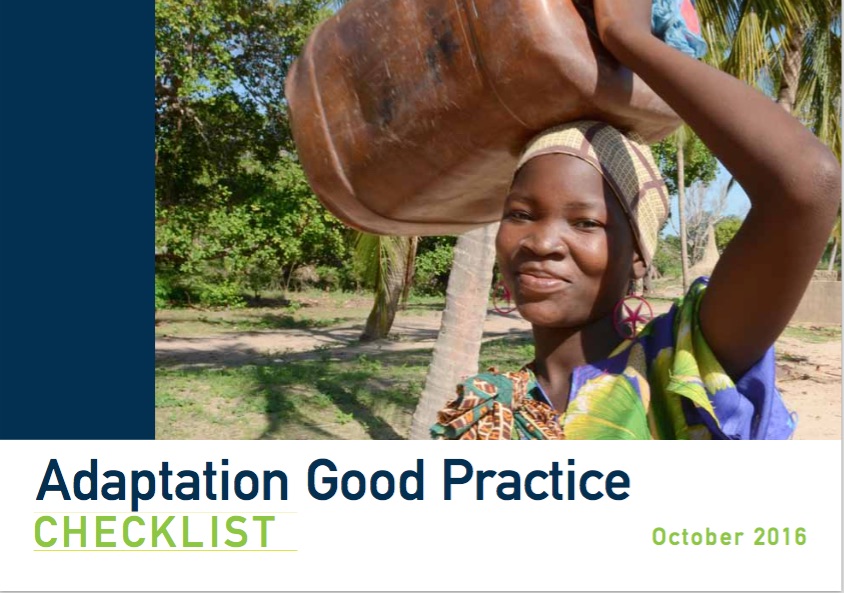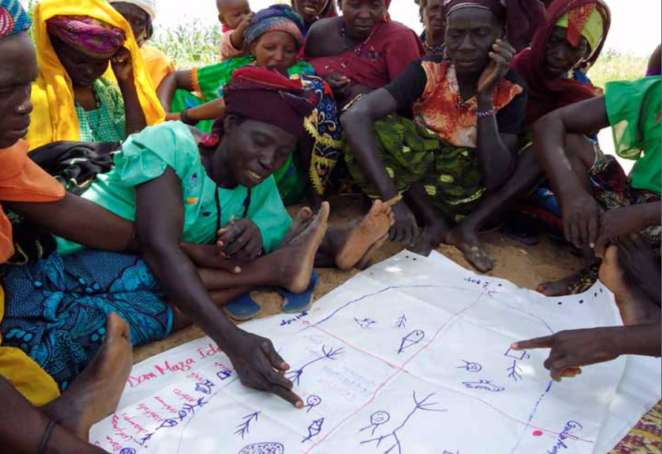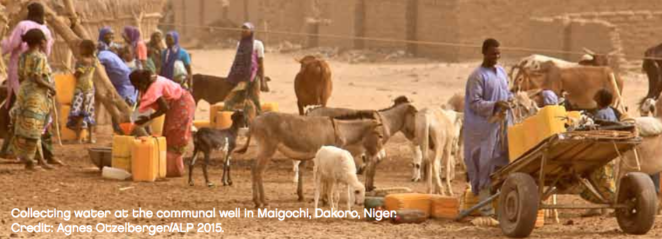Adaptation Good Practice (AGP) Checklist

Introduction
The UNFCCC Paris Agreement creates the framework for increased financial flows for adaptation to the impacts of climate change. The Adaptation Good Practice Checklist provides guidance on actions and criteria which help to ensure that adaptation results in quality, impactful and long-term climate resilience for the most vulnerable people.
AGP checklist, NDCs and Adaptation Finance
The nine practices in the AGP checklist define the range of activity areas that are needed for adaptation to climate change. They are derived from a synthesis of practical experience in Africa, UNFCCC and Green Climate Fund documents on adaptation planning, finance, gaps, paradigm shifts and social environmental safeguards.
The checklist* supports design, decisions, capacity building, implementation and monitoring of adaptation, in relation to the roll out of Nationally Determined Contributions (NDCs), National Adaptation Plans (NAPs) and adaptation finance. It can be used to inform or screen concepts, proposals, implementation plans and national budgets for their incorporation of and compliance with adaptation good practices, and to determine the focus of research and capacity building.
*Download the Checklist from the right-hand column.
Using the Checklist
The AGP checklist document describes underlying concepts, a set of nine practices with criteria for assessment, a practical scoring method and useful resources and information. Additional resources on experiences with testing and using the AGPs and detailed information on each practice are forthcoming.
Who is the checklist for?
- Planners and proposal development teams to guide designs for NAPs, the Green Climate Fund (GCF), the Adaptation Fund (AF) and other financing mechanisms.
- Regional and national Implementing Entities (RIEs / NIEs), development banks, donors, and the AF and GCF boards to evaluate quality and effectiveness.
- Executing Entities and programme implementers to guide detailed design of adaptation processes and activities with stakeholders.
- Capacity building course developers to design curricula.
Using the AGP checklist
The checklist can be used in a variety of ways, to:
- Engage proposal design teams in discussions on what good adaptation would look like in the particular context, vulnerable groups, prioritised sector and geographic areas agreed upon.
- Guide project or programme designs, roll out of NAPs/NDCs and implementation teams to include essential practices and approaches to support successful, sustainable adaptation outcomes and impacts.
- Guide appraisal, evaluation or screening of concepts and proposals in relation to adaptation content ensuring they satisfy the criteria for good adaptation at all levels.
- Guide content development of research, training and capacity building programmes for adaptation Inform national budget coding for climate finance.
- Conduct a desk exercise or stakeholder discussions using the AGPs as a tool to trigger reflections on how good adaptation can be realised on the ground.
- Inspire and document dynamic evolution of adaptation good practice as it continues to be informed by emerging learning from practical experiences in response to climate change and uncertainty.

The Adaptation Good Practices
From page 4 of the Checklist:
- Risk, vulnerability and capacity: Analyse climate risks, differential vulnerability and capacity of people, ecosystems and institutions.
- Participation, inclusion and gender equality: Ensure participation, agency, transparency and inclusion of all groups.
- Climate information and uncertainty: Incorporate management of uncertainty and use of climate information.
- Planning and decision making processes: Promote anticipatory, flexible and forward looking adaptation planning and decision making processes.
- Innovation, local and indigenous knowledge and technology: Promote innovation, local (including traditional and indigenous) knowledge and technology.
- Adaptive management: Ensure an integrated and holistic response with adaptive management of climate related risks and impacts over time.
- Institutional linkages: Establish institutional arrangements and linkages which facilitate multi-stakeholder engagement.
- Learning, capacity building and knowledge management: Integrate learning, capacity building, monitoring and knowledge management processes.
- Scaling up and sustainability: Support ongoing and sustainable adaptation at scale.
Concepts which underpin the practices
From pages 5-6 of the Checklist:
- Climate change risks and impacts are highly diverse and context-specific. Planning for adaptation therefore needs to be locally driven and across sectors, and incorporate appropriate local and external resources, expertise and knowledge. Different groups have differing levels of vulnerability and capacity within and across populations and communities that need to be considered. As a result, differences in gender, social status, wealth, ethnicity, natural resource base, marginalization, and religion, among others; all affect people’s ability to adapt and are important aspects to understand and work with.
- Timescales matter.Climate change occurs in short to long-term timescales, with direct and indirect changes and impacts. Institutions and systems must consider the linkage of adaptation work across time scales and integrate continuous learning on adaptation.
- Uncertainty – climate changes and resultant risks and impacts are difficult to predict with certainty. A framework must be developed with the appropriate flexibility to evolve with the changing climate risks, uncertainties, opportunities and impacts. Adaptation must go beyond being reactive to climate impacts, to focusing on anticipatory and precautionary measures to be prepared for future unknowns.
- Adaptive capacity of vulnerable people, ecosystems and institutions is a critical determinant of successful adaptation in the face of an uncertain future climate. Strengthening control of and access to knowledge and assets, strong institutions and linkages, innovation, anticipation of future risks and opportunities and above all forward looking decision making processes are the capacities which form the basis for adaptation actions to be identified and implemented now and into the future as the climate changes. These capacities ensure that adaptation technologies are relevant and effective. These capacities therefore require equal attention in terms of resourcing the systems and services which build and maintain adaptive capacity.
- Decision-making processes are at the heart of effective adaptation. The changing climate requires continuous and informed decision-making, reviewing past trends, current conditions and anticipating future scenarios. This calls for systems and processes, which motivate and sustain anticipatory, flexible, locally contextualised decision-making, in which those affected by climate impacts are fully involved.
- Underlying causes and drivers of vulnerability – for example, gender inequalities, exclusion or poor governance – and ongoing development and economic growth challenges all affect resilience to climate change and may hinder the success of the implementation of adaptation actions. A holistic response which takes these into account together with climate risks is needed in which adaptation is integrated, embedding climate change across all sectors and within all policy settings and decision making processes.
- Climate Information Services– access to available and useful climate information contributes to increasing resilience and adaptive capacity of vulnerable groups, (eco)systems and institutions to the impacts of climate change. Factors such as working with uncertainty and scenarios; valuing and integrating indigenous knowledge; interpretation of scientific and meteorological information; engagement of users in creating usable and accessible information, and effective communication to those who need it are key to building resilience and adaptation to climate change impacts.
- Non-climate benefits of adaptation – adaptation aims to ensure socio-economic development at all levels is climate resilient, hence effective and coherent approaches to adaptation are relevant beyond climate specific issues and will contribute to key development objectives, increased equality and poverty reduction, as enshrined in the Sustainable Development Goals (SDGs).
Against this background, the checklist aims to reflect the latest knowledge on adaptation practices which respond to ongoing climate change and variability, risks, vulnerability and impacts.

The AGP checklist was written by Fiona Percy and Philip Oyoo. Jemimah Maina, Maurine Ambani, Emma Bowa, Peterson Mucheke and Nicola Ward provided critical background work, facilitation of testing, editing and design support.
Suggested Citation
Percy, F. and Oyoo, P. (2016) Adaptation Good Practice Checklist. Adaptation Learning Programme for Africa (ALP). CARE International: London, UK.
(2) Comments
Thanks for the article. Very much appropriate and timely for the type of work i am currently doing.
Thanks for the article. It has information that I was searching for the change project that I am handling now.